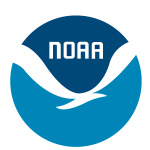- Industry: Government
- Number of terms: 30456
- Number of blossaries: 0
- Company Profile:
NOAA Coral Reef Conservation Program, National Oceanic and Atmospheric Administration, U.S. Department of Commerce
A large purse seiner, usually more than 70 meters long and equipped with considerable freezing and storage facilities, capable of undertaking extended transoceanic voyages for harvesting fish.
Industry:Fishing
A plan that covers impacts to listed species from activities of state and local governments, under section 4(d) of the Endangered Species Act (ESA).
Industry:Fishing
1. The fraction of a fish population which lives in regions where it is susceptible to fishing during a given fishing season. This fraction receives recruits from or becomes mingled with the non-available part of the stock at other seasons, or in other years (any more or less completely isolated segment of the population is best treated as a separate stock); 2. The proportion of a stock which is susceptible to fishing. Fish become "available" to fisheries through migration, growth and /or change of behavior (from pelagic to demersal). If an available section of a stock is sufficiently isolated from the rest of the stock, it could be considered a management unit and be managed as such; 3. Describes whether a certain kind of fish of a certain size can be caught by a type of gear in an area.
Industry:Fishing
A type of financial analysis that compares the timing and amount of cash inflows with the timing and amount of cash outflows. A firm's cash flow position can greatly affect its ability to remain in business. These effects may not be apparent from a cost-benefit analysis.
Industry:Fishing
An approach that takes major ecosystem components and services-both structural and functional-into account in managing fisheries. It values habitat, embraces a multispecies perspective, and is committed to understanding ecosystem processes. Its goal is to rebuild and sustain populations, species, biological communities, and marine ecosystems at high levels of productivity and biological diversity so as not to jeopardize a wide range of goods and services from marine ecosystems while providing food, revenue, and recreation for humans.
Industry:Fishing
1. The environment in which the fish live, including everything that surrounds and affects its life, e.g. water quality, bottom, vegetation, associated species (including food supplies); 2. The locality, site and particular type of local environment occupied by an organism.
Industry:Fishing
Benchmarks used to indicate when harvests should be constrained substantially so that the stock remains within safe biological limits. The probability of exceeding limits should be low. In the National Standard Guidelines, limits are referred to as thresholds. In much of the international literature (e.g. United Nations Food and Agricultural Organization, FAO) thresholds are used as buffer points that signal when a limit is being approached.
Industry:Fishing
A breakdown of the different age groups of a kind of fish in a population or sample.
Industry:Fishing
A level of fishing pressure that threatens to reduce a stock or complex below the abundance necessary to support maximum sustainable yield (MSY) and allow an economically sustainable fishing industry.
Industry:Fishing
A falling tide, the phase of the tide between high water and the succeeding low water.
Industry:Fishing
